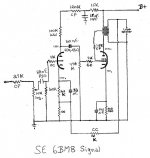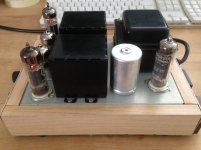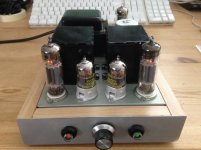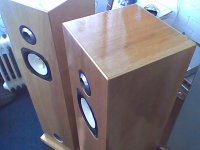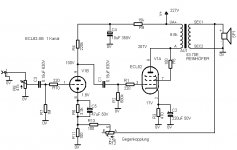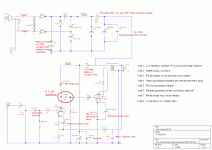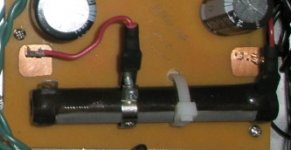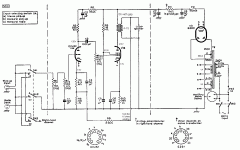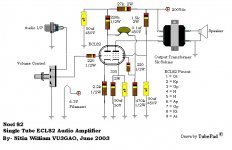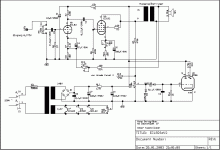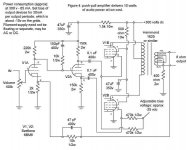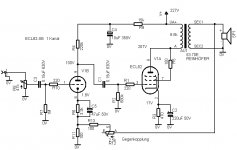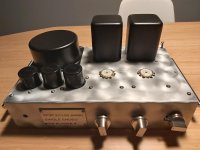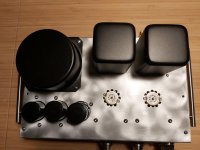Hi geezoID,
I did many, many years ago, as well with ECL86 - another fine tube not anymore in production.
My version had NOS Ei ECL82 with 2 extra ECC83 for RIAA stage, later I abandoned Pentode mode in favor for Triode connection. The power fell down to well below 1 Watt per channel but with significant improvement in sound. I used standard Philips data-book recommendation for operating points.
Needless to say - you will need super high sensitivity speakers to be useful.
I had at that time paired with Fostex FE167E and it was not enough sensitive for moderate room size.
It would be nice if you could use 6BM8/ECL82 in RH mode with plate-to-plate feedback and extract all it can while retaining triode quality of sound.
Best regards,
I did many, many years ago, as well with ECL86 - another fine tube not anymore in production.
My version had NOS Ei ECL82 with 2 extra ECC83 for RIAA stage, later I abandoned Pentode mode in favor for Triode connection. The power fell down to well below 1 Watt per channel but with significant improvement in sound. I used standard Philips data-book recommendation for operating points.
Needless to say - you will need super high sensitivity speakers to be useful.
I had at that time paired with Fostex FE167E and it was not enough sensitive for moderate room size.
It would be nice if you could use 6BM8/ECL82 in RH mode with plate-to-plate feedback and extract all it can while retaining triode quality of sound.
Best regards,
Attachments
That is a very nicely built amplifier, and good looking speakers.
I would be glad to have a set of those ported enclosures and 2-way speakers (what tweeters, enclosure dimensions, and port dimensions)?
Is there a thread in the speakers part of the forum?
The speakers would work fine with my low power (but not real low power) amplifiers.
Eli's Ultra Linear circuit looks like a good one, with simplicity (if the output transformer has the UL taps to be able to do that), and the Ultra Linear mode would have output power, distortion, and damping factor, that is right in the middle between Pentode and Triode modes.
I never got my RH based designs to work the way I wanted them to (too little patience to get it adjusted just right).
I used to dislike Ultra Linear mode, but now have designed both SE and Push Pull amps with UL that I like.
I hope geezoID finds a design he likes, builds it, and enjoys it.
'Advice' to everyone, design, build, and sit back and listen. Enjoy!
I apologize for "preaching to the choir".
I would be glad to have a set of those ported enclosures and 2-way speakers (what tweeters, enclosure dimensions, and port dimensions)?
Is there a thread in the speakers part of the forum?
The speakers would work fine with my low power (but not real low power) amplifiers.
Eli's Ultra Linear circuit looks like a good one, with simplicity (if the output transformer has the UL taps to be able to do that), and the Ultra Linear mode would have output power, distortion, and damping factor, that is right in the middle between Pentode and Triode modes.
I never got my RH based designs to work the way I wanted them to (too little patience to get it adjusted just right).
I used to dislike Ultra Linear mode, but now have designed both SE and Push Pull amps with UL that I like.
I hope geezoID finds a design he likes, builds it, and enjoys it.
'Advice' to everyone, design, build, and sit back and listen. Enjoy!
I apologize for "preaching to the choir".
Hi,
Thanks for comments, those speakers were built by me for a friend. He found on internet the design He likes ( I think from Bob Brines ) and ask me to make for Him one pair - as a payoff for trouble I could used them as long as I want.
At the same time I had this small amp built in the chassis of old CD-ROM drive - the match was really good but lacking power level for my room. Drivers were from Fostex - FE167E & FT17H with just 1 capacitor for the tweeter.
By now, nor the Bob Brines makes/sells speakers/plans nor the Fostex makes this full-range woofer anymore and the plans were only available as paid plan set.
I think new Fostex series FE166NV would be even better suited for ported/MLTL design then the old ones, or even FF165WK with the same tweeter would do a better job as a 2-way.
I'm with you regarding Ultra-linear mode - could not stand sound for many decades - especially in PP, the Pentode or Triode mode was to my ears way better then UL compromise. I never listened to the UL in SE mode...
I don't have drawings from this little amp but I remember using some Japan/German sites to confirm working points for Triode connection - one example:
Thanks for comments, those speakers were built by me for a friend. He found on internet the design He likes ( I think from Bob Brines ) and ask me to make for Him one pair - as a payoff for trouble I could used them as long as I want.
At the same time I had this small amp built in the chassis of old CD-ROM drive - the match was really good but lacking power level for my room. Drivers were from Fostex - FE167E & FT17H with just 1 capacitor for the tweeter.
By now, nor the Bob Brines makes/sells speakers/plans nor the Fostex makes this full-range woofer anymore and the plans were only available as paid plan set.
I think new Fostex series FE166NV would be even better suited for ported/MLTL design then the old ones, or even FF165WK with the same tweeter would do a better job as a 2-way.
I'm with you regarding Ultra-linear mode - could not stand sound for many decades - especially in PP, the Pentode or Triode mode was to my ears way better then UL compromise. I never listened to the UL in SE mode...
I don't have drawings from this little amp but I remember using some Japan/German sites to confirm working points for Triode connection - one example:
Attachments
Eli asked me to post the schematics for the 6BM8 amp that he and a few others of us worked on a few years ago. Here is the schematic with a few notes. Note that the PS was still under adjustment, hence the variable resistor shown. It was helpful to set the proper B+ level, and then removed and replaced with fixed values. If I recall, 950 Ohms turned out to be near the final result. I'm attaching a picture of the schematic, the amp, and that resistor at its final position.
Attachments
I think new Fostex series FE166NV would be even better suited for ported/MLTL design then the old ones, or even FF165WK with the same tweeter would do a better job as a 2-way.
Given that the older FExx6 were not at all happy in a ported/MLTL design that wouldn’t be hard. FF165wk IMO better in all respects (except not quite as sensitive, but without a horn on the FExx6 moot).
dave
No bang, no flash, just music!
Pics of my 6BM8 - The Gnat....
A variation with ECL86 can be done.
dave
I would say, if you have the parts - just build it - you can always change or adjust later on.
This tube is also often used in triode strapped mode as a driver for hungry output tubes like 2A3,300B without sonic penalty.
This tube is also often used in triode strapped mode as a driver for hungry output tubes like 2A3,300B without sonic penalty.
I wish Jeff's outstanding effort could be tried with a pair of Klipschorns. 😉
I wish I could afford a pair of Klipschhorns!
My first tube amp for HiFi was very similar to Dave's schematic except it had the "Shade" feedback - a 330k resistor between triode and pentode plate. No other feedback and no UL. Except for the lack of bottom end due to the miserable output transformers it was quite enjoyable and fairly loud into a pair of FF127k speakers. As an aside, the full-range speakers didn't help the bottom end either. The B+ was way too high for the tubes, and as a result I tore it apart. Unfortunately I don't have a schematic, but it got me sold on the Shade feedback concept.
Here is another, good one.
I am also building an ECL82, and use the first schematics, the one in color. Not finished yet..
Attachments
No bang, no flash, just music!
Pics of my 6BM8 - The Gnat....
A variation with ECL86 can be done.
dave
Strange schemo- the Pentode misses the cathode cap, but the driver has one- that makes for very great signal amplification and high sensitivity.
- Home
- Amplifiers
- Tubes / Valves
- 6BM8 as SE
